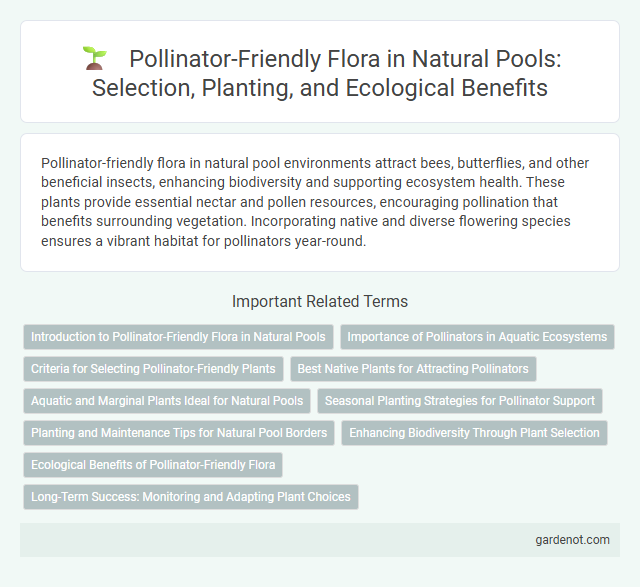Pollinator-friendly flora in natural pool environments attract bees, butterflies, and other beneficial insects, enhancing biodiversity and supporting ecosystem health. These plants provide essential nectar and pollen resources, encouraging pollination that benefits surrounding vegetation. Incorporating native and diverse flowering species ensures a vibrant habitat for pollinators year-round.
Introduction to Pollinator-Friendly Flora in Natural Pools
Pollinator-friendly flora in natural pools includes native wildflowers, flowering shrubs, and aquatic plants that attract bees, butterflies, and other beneficial insects. These plants provide essential nectar and pollen sources, supporting local biodiversity and enhancing the ecological balance of the pool environment. Incorporating species like milkweed, coneflowers, and water lilies promotes pollination services and helps sustain healthy pollinator populations.
Importance of Pollinators in Aquatic Ecosystems
Pollinator-friendly flora in natural pools supports diverse insect species like bees, butterflies, and hoverflies essential for ecosystem stability. These pollinators facilitate the reproduction of aquatic and marginal plants, enhancing biodiversity and water quality through natural filtration. Protecting pollinator habitats in and around natural pools strengthens aquatic food webs and promotes resilient, balanced ecosystems.
Criteria for Selecting Pollinator-Friendly Plants
Pollinator-friendly plants in natural pools should be selected based on criteria such as native species compatibility, bloom period diversity, and the availability of nectar and pollen sources. Plants must provide continuous food resources throughout the pollinator active seasons to support diverse pollinator species like bees, butterflies, and hummingbirds. Choosing flora with varying flower shapes and colors enhances pollinator attraction and supports ecosystem biodiversity within the natural pool environment.
Best Native Plants for Attracting Pollinators
Native plants such as milkweed, coneflowers, and goldenrod are essential for creating a natural pool that supports pollinator-friendly flora. These species provide nectar and pollen for bees, butterflies, and hummingbirds, promoting biodiversity and ecosystem health. Incorporating a variety of native wildflowers ensures continuous bloom cycles that attract and sustain pollinators throughout the growing season.
Aquatic and Marginal Plants Ideal for Natural Pools
Aquatic and marginal plants such as water lilies, pickerelweed, and arrowhead provide essential habitats and food sources for pollinators in natural pools. These pollinator-friendly flora support biodiversity by attracting bees, butterflies, and other beneficial insects while contributing to water purification and ecosystem balance. Incorporating diverse native aquatic species enhances the ecological function and visual appeal of natural pools.
Seasonal Planting Strategies for Pollinator Support
Selecting pollinator-friendly flora such as milkweed, coneflowers, and lavender ensures a continuous nectar supply throughout the seasons in a natural pool environment. Implementing seasonal planting strategies involves staggering bloom times from early spring to late fall to support bees, butterflies, and other pollinators year-round. Prioritizing native, drought-tolerant species enhances habitat resilience while maximizing pollination efficiency and biodiversity in the ecosystem.
Planting and Maintenance Tips for Natural Pool Borders
Planting pollinator-friendly flora such as lavender, milkweed, and beeswax plants along natural pool borders enhances biodiversity and supports essential pollinator species. Maintain these plants by ensuring soil quality through organic mulch application, regular watering during dry periods, and avoiding chemical fertilizers or pesticides that harm pollinators. Periodic pruning and deadheading encourage vigorous growth and continuous blooming, creating an inviting habitat for bees, butterflies, and other beneficial insects.
Enhancing Biodiversity Through Plant Selection
Selecting pollinator-friendly flora for natural pools significantly enhances biodiversity by attracting bees, butterflies, and other essential pollinators. Native plants such as milkweed, lavender, and coneflower provide vital nectar and pollen sources that support local ecosystems. Incorporating diverse plant species not only sustains pollinator populations but also promotes overall ecological balance within the aquatic environment.
Ecological Benefits of Pollinator-Friendly Flora
Pollinator-friendly flora in natural pools supports biodiversity by providing essential habitats for bees, butterflies, and other pollinators, enhancing local ecosystems. These plants improve water quality by reducing runoff and filtering pollutants through their root systems. Incorporating native, nectar-rich species promotes balanced interactions between aquatic life and terrestrial pollinators, fostering resilience against environmental changes.
Long-Term Success: Monitoring and Adapting Plant Choices
Pollinator-friendly flora in natural pools requires ongoing monitoring and adaptive management to ensure long-term ecological balance and biodiversity. Selecting native flowering plants that attract bees, butterflies, and other pollinators promotes sustainable habitat creation while enhancing water quality through natural filtration. Regular assessment helps identify plant health, density, and pollinator activity, enabling strategic adjustments that maintain the pool's resilience and support ecosystem services over time.
Pollinator-friendly flora Infographic

 gardenot.com
gardenot.com